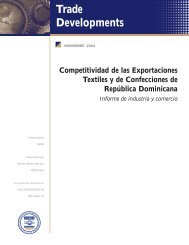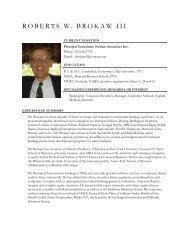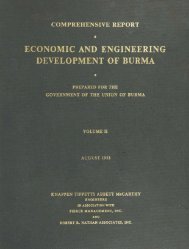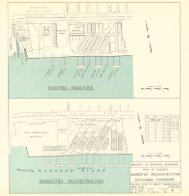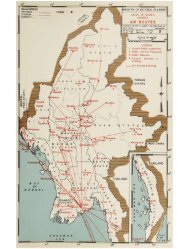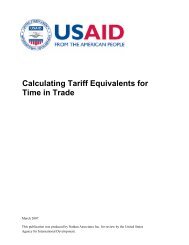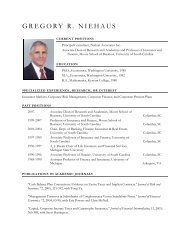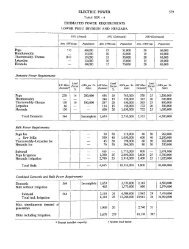Forced Labor under the Third Reich - Nathan Associates
Forced Labor under the Third Reich - Nathan Associates
Forced Labor under the Third Reich - Nathan Associates
You also want an ePaper? Increase the reach of your titles
YUMPU automatically turns print PDFs into web optimized ePapers that Google loves.
FORCED LABOR UNDER THE THIRD REICH part one
1.<br />
Introduction<br />
<strong>Forced</strong> labor1 sustained <strong>the</strong><br />
German economy of <strong>the</strong> <strong>Third</strong> <strong>Reich</strong> during<br />
World War II. As many as 12 million people2 were forced to work for little or no pay. They<br />
came from Poland, Yugoslavia, <strong>the</strong> Soviet<br />
Union, Czechoslovakia, France, Belgium, and<br />
o<strong>the</strong>r countries, including neutral countries<br />
or those allied with <strong>the</strong> <strong>Third</strong> <strong>Reich</strong>. In 1999,<br />
approximately 2.3 million3 of <strong>the</strong>se forced<br />
laborers were still living.<br />
The law firm of Cohen, Milstein, Hausfeld &<br />
Toll asked <strong>Nathan</strong> <strong>Associates</strong> Inc. to <strong>under</strong>take<br />
two tasks. The first task was to bring<br />
toge<strong>the</strong>r in a consistent framework <strong>the</strong> various<br />
estimates of <strong>the</strong> total number of foreign<br />
forced laborers during World War II and of<br />
<strong>the</strong> number of survivors of this labor. These<br />
estimates are presented in Part I. The second<br />
task was to estimate <strong>the</strong> economic value of<br />
<strong>the</strong> forced labor brought up to <strong>the</strong> present<br />
day. This estimate is presented in Part II.<br />
We approached <strong>the</strong>se tasks with humility<br />
because of <strong>the</strong> research demanded by <strong>the</strong> passage<br />
of 60 years or more, <strong>the</strong> outstanding<br />
part one<br />
scholarship by o<strong>the</strong>rs on <strong>the</strong> subject of forced<br />
labor during <strong>the</strong> <strong>Third</strong> <strong>Reich</strong>, <strong>the</strong> magnitude<br />
of <strong>the</strong> numbers of people who suffered as<br />
forced laborers, and because even modest<br />
economic compensation for each survivor<br />
amounts to billions of dollars for <strong>the</strong> survivors<br />
as a group.<br />
Wartime conditions and <strong>the</strong> passage of time<br />
mean that <strong>the</strong> requisite information on<br />
forced labor <strong>under</strong> <strong>the</strong> <strong>Third</strong> <strong>Reich</strong> is not<br />
always available. The remaining original<br />
sources of data are likely to be found in <strong>the</strong><br />
extant archives of <strong>the</strong> <strong>Third</strong> <strong>Reich</strong> and German<br />
companies that used forced labor. Those who<br />
research <strong>the</strong> issue must reconcile differing<br />
estimates, often by relying on interviews with<br />
surviving forced laborers and members of <strong>the</strong><br />
<strong>Third</strong> <strong>Reich</strong>.<br />
We relied principally on three scholarly studies.<br />
The earliest of <strong>the</strong>se was conducted by John<br />
H.E. Fried in late 1944 while he was a staff<br />
member of <strong>the</strong> International Labour Office<br />
(ILO). In The Exploitation of Foreign Labour by<br />
Germany (Montreal, 1945), Mr. Fried provides<br />
<strong>the</strong> most detailed accounting of forced labor<br />
in Germany during World War II that was<br />
available to us. Our second source was<br />
Edward L. Homze, who began his research on<br />
forced labor as a history student at<br />
Pennsylvania State University. His 1963<br />
dissertation, Foreign <strong>Labor</strong> in Nazi Germany, was<br />
revised, updated, and published by Princeton<br />
University Press in 1967. The most recent<br />
1
2 FORCED LABOR UNDER THE THIRD REICH<br />
study on which we have relied is Ulrich<br />
Herbert’s Hitler’s Foreign Workers: Enforced Foreign<br />
<strong>Labor</strong> in Germany Under <strong>the</strong> <strong>Third</strong> <strong>Reich</strong>. First published<br />
in German in 1985, it is now available<br />
in English from Cambridge University Press<br />
(1997). Professor Herbert is a historian at Albert<br />
Ludwig University, Freiberg-im-Breisgau.<br />
We also consulted Dr. Lutz Niethammer’s<br />
“Policy Paper for <strong>the</strong> Chef des<br />
Bundeskanzleramtes Relating to Current<br />
Questions on <strong>the</strong> Compensation of <strong>Forced</strong><br />
Workers,” and proceedings of <strong>the</strong> July 1999<br />
International Workshop on Nazi <strong>Forced</strong><br />
<strong>Labor</strong>, which was organized by Dr.<br />
Niethammer. A Professor of Current Affairs<br />
at Friedrich-Schiller-Jena University, Dr.<br />
Niethammer is at present a Jean Monnet<br />
Fellow at <strong>the</strong> European University Institute<br />
in Florence, Italy.<br />
In addition to <strong>the</strong>se sources, we have made<br />
extensive use of information available<br />
through private nonprofit organizations and<br />
foundations established in Poland, <strong>the</strong> Czech<br />
Republic, Belarus, Russia, and <strong>the</strong> Ukraine to<br />
represent <strong>the</strong> interests of surviving forced<br />
laborers; and we have consulted with <strong>the</strong><br />
Conference on Jewish Material Claims<br />
Against Germany (Claims Conference) and<br />
<strong>the</strong> United Nations High Commission for<br />
Refugees. The principal tasks of <strong>the</strong>se groups<br />
is to identify survivors, record data on <strong>the</strong>ir<br />
experience, and verify through o<strong>the</strong>r sources<br />
<strong>the</strong> accuracy of a survivor’s recounting of his<br />
or her experience. Their procedures are rigorous<br />
and much of <strong>the</strong>ir data are in computerized<br />
databases. These foundations and <strong>the</strong>ir<br />
representatives are listed in Appendix A.<br />
1 The term forced labor subsumes all categories of involuntary labor.<br />
2 Dr. Lutz Niethammer, “Policy Paper for <strong>the</strong> Chef des<br />
Bundeskanzleramtes Relating to Current Questions on <strong>the</strong><br />
Compensation of <strong>Forced</strong> Workers,” Florence, Italy, January 14,<br />
1999, p. 3.<br />
3 This estimate is from <strong>the</strong> foundations and organizations listed in<br />
Appendix A. The estimate is explained in Section 3.
2.<br />
Use and Effect of<br />
<strong>Forced</strong> <strong>Labor</strong><br />
An estimate of <strong>the</strong> total<br />
number of forced laborers <strong>under</strong> <strong>the</strong> <strong>Third</strong><br />
<strong>Reich</strong> during World War II must be pieced<br />
toge<strong>the</strong>r from different sources. Because <strong>the</strong><br />
number of workers and <strong>the</strong>ir activities can<br />
change from month to month, a profile developed<br />
from one source covering one time period<br />
might look significantly different from <strong>the</strong><br />
profile developed from ano<strong>the</strong>r source or even<br />
<strong>the</strong> same source for a different time period.<br />
The three researchers (Herbert, Homze, and<br />
Fried) on whom we have relied worked independently<br />
and at different times. Their estimates,<br />
which are presented in Appendix B,<br />
differ because of different dates of worker<br />
enumeration, different definitions of geographic<br />
regions of origin, and different source<br />
material. Herbert reports data from Der<br />
Arbeitseinsatz im Großdeutschen <strong>Reich</strong>, No.<br />
11/12, December 30, 1944. Homze’s estimates<br />
were derived from statistics reported by <strong>the</strong><br />
United States Strategic Bombing Survey after<br />
adjusting <strong>the</strong> official Nazi statistical records.<br />
Fried’s estimates were based on information<br />
part one<br />
communicated to <strong>the</strong> International <strong>Labor</strong><br />
Office by Dr. Eugene M. Kulischer with <strong>the</strong><br />
cooperation of J. B. Schechtmann.<br />
At <strong>the</strong> peak of <strong>the</strong> war, one of every five<br />
workers in <strong>the</strong> economy of <strong>the</strong> <strong>Third</strong> <strong>Reich</strong><br />
was a forced laborer. According to Fried, in<br />
January 1944 <strong>the</strong> <strong>Third</strong> <strong>Reich</strong> was relying on<br />
10 million forced laborers. Of <strong>the</strong>se, 6.5<br />
million were civilians within German borders,<br />
2.2 million were prisoners of war, and 1.3 million<br />
were located at forced labor camps outside<br />
Germany’s borders. 4 Homze reported that<br />
civilian forced laborers from o<strong>the</strong>r countries<br />
working within <strong>the</strong> German borders rose<br />
steeply from 300,000 in 1939 to more than 5<br />
million in 1944 (see Figure 1).<br />
The <strong>Third</strong> <strong>Reich</strong>’s strategy of using forced<br />
labor to satisfy its wartime needs arose from<br />
necessity. German men were engaged in battle<br />
and national socialist ideology precluded<br />
using German women.<br />
From <strong>the</strong> mid-1930’s onwards, as <strong>the</strong> growing<br />
manpower shortage began to threaten <strong>the</strong> very existence<br />
of <strong>the</strong> Nazi regime, <strong>the</strong> authorities were forced<br />
with <strong>the</strong> choice of conscripting ei<strong>the</strong>r German<br />
women or foreign nationals... However, <strong>the</strong><br />
deployment of [German] women as workers was<br />
far more unpopular, and would upset <strong>the</strong> already<br />
precarious domestic political balance of <strong>the</strong><br />
regime. Fur<strong>the</strong>rmore, it contradicted national<br />
Socialist ideology regarding <strong>the</strong> role of women,<br />
and <strong>the</strong> deep convictions of a large segment of <strong>the</strong><br />
population. . .[There was] <strong>the</strong> basic and (on <strong>the</strong><br />
German side) deliberate decision to plug <strong>the</strong> holes in<br />
<strong>the</strong> German labor market by using foreign nationals<br />
ra<strong>the</strong>r than German women. (Herbert, pp. 58-59).<br />
3
4 FORCED LABOR UNDER THE THIRD REICH<br />
During <strong>the</strong> first two years of <strong>the</strong> war, <strong>the</strong>re<br />
was no significant strain on German manpower,<br />
but after <strong>the</strong> Russian campaign manpower<br />
requirements escalated, and <strong>the</strong> number<br />
of civilian forced laborers rose sharply.<br />
The conscription of foreign civilians was<br />
accomplished by a “cooperative structure”<br />
between <strong>the</strong> National Socialist regime and<br />
private industry. 5 This repression of forced<br />
laborers was not a mere consequence of <strong>Third</strong><br />
<strong>Reich</strong> policies, but a responsibility shared<br />
between industry, <strong>the</strong> Nazi Party, and <strong>the</strong><br />
Government.<br />
About two-thirds of <strong>the</strong> forced laborers were<br />
from countries to <strong>the</strong> east of Nazi Germany.<br />
Most of <strong>the</strong>se were from Poland and countries<br />
that composed <strong>the</strong> former Soviet Union (see<br />
Table 1). Of <strong>the</strong> remaining laborers who were<br />
from countries west of Nazi Germany, about<br />
half were from occupied France. Relatively<br />
few (about 1 percent) forced laborers were<br />
from countries that were allies of Nazi<br />
Germany or neutral.<br />
<strong>Forced</strong> labor was found mainly in three<br />
sectors of <strong>the</strong> economy of <strong>the</strong> <strong>Third</strong> <strong>Reich</strong>:<br />
agriculture, mining, and manufacturing.<br />
Approximately 1 million forced laborers from<br />
Poland worked in agriculture. 6 The mining<br />
industry in Germany, which produced essential<br />
coal and iron ore, also was dependent on<br />
forced laborers from German-occupied<br />
countries.<br />
Early in <strong>the</strong> war, most civilian forced laborers<br />
were working in <strong>the</strong> agricultural sector, but<br />
by <strong>the</strong> end of <strong>the</strong> war manufacturing, including<br />
war material manufacturing, was competing<br />
with agriculture for <strong>the</strong> services of forced<br />
laborers (see Figure 2). Before <strong>the</strong> end of <strong>the</strong><br />
war, more civilian forced laborers were<br />
working in industry than in any o<strong>the</strong>r sector,<br />
with a significant number concentrated in<br />
war production. 7<br />
4 This figure, cited by Fried (p. 264-5), is based on information<br />
provided to <strong>the</strong> International <strong>Labor</strong> Office sometime during<br />
1944, and includes Polish and French POWs that were converted<br />
to “free” civilian workers. The Fried enumeration is used here<br />
because it has <strong>the</strong> most comprehensive attribution of <strong>the</strong> nationality<br />
of Germany’s forced laborers. In addition, <strong>the</strong> attribution<br />
date of this enumeration, January 1944, coincides with <strong>the</strong> high<br />
point in <strong>the</strong> number of foreign workers employed in <strong>the</strong> <strong>Reich</strong><br />
at one time.<br />
5 The concept of shared responsibility was recognized at <strong>the</strong><br />
International Workshop on Nazi <strong>Forced</strong> <strong>Labor</strong> held in<br />
Buchenwald, July 8-10, 1999. Additional references on this matter<br />
include Herbert, Fremdarbeiter. Politik und Praxis des<br />
“Auslander-Einsatzes” in der Kriegswirtschaft des Dritten<br />
<strong>Reich</strong>es [Foreign Workers. Policy and Practice of <strong>the</strong> “Utilization of<br />
Foreigners” in <strong>the</strong> Wartime Economy of <strong>the</strong> <strong>Third</strong> <strong>Reich</strong>] (2nd ed. 1986);<br />
see also Herbert, Geschichte der Auslanderbeschaftigung in<br />
Deutschland 1880-1980. [The History of Foreign Employment in Germany<br />
1880-1980] (1986); H. Mommsen, Das Volkswagenwerk und<br />
seine Arbeiter im Dritten <strong>Reich</strong> [The Volkswagen Factory and Its<br />
Workers in <strong>the</strong> <strong>Third</strong> <strong>Reich</strong>] (1996); Sofsky, Die Ordnung des Terrors:<br />
Das Daimler-Benz-Buch [The Daimler-Benz Book] (1987); Frobe et al.,<br />
Konzentrationslager in Hannover [Concentration Camp in Hannover]<br />
(1985); Siegfried, Rustungsproduktion und Zwagsarbeit im<br />
Volkswagenwerk 1939-1945 [Armaments Production and <strong>Forced</strong> <strong>Labor</strong> in<br />
<strong>the</strong> Volkswagen Factory] (1986); Pingel, Haftlinge unter SS-<br />
Herrshaft. Widerstand, Selbstbehauptung und Vernichtung im<br />
Kozentrationslager [Prisoners Under SS Control: Resistance, Self-Assertion,<br />
and Extermination in <strong>the</strong> Concentration Camp], (1978); see also Herbert,<br />
in Barwig et al., supra note 4, at 17 et seq., at n.3-4.<br />
6 Herbert, p. 1.<br />
7 U.S. Strategic Bombing Survey, Overall Economic Effects Division,<br />
“The Effects of Strategic Bombing on <strong>the</strong> German War Economy.”<br />
October 31, 1945, p. 31.
Figure 1<br />
6<br />
5<br />
4<br />
3<br />
2<br />
1<br />
0<br />
Civilian <strong>Forced</strong> <strong>Labor</strong>ers in Nazi Germany<br />
May 31, 1939-1945<br />
SOURCE: <strong>Nathan</strong> <strong>Associates</strong> Inc. based on data from Homze, pp. 233, 235.<br />
part one<br />
1939 1940 1941 1942 1943 1944<br />
In Millions<br />
5
6 FORCED LABOR UNDER THE THIRD REICH<br />
Table 1<br />
Foreign Civilian <strong>Forced</strong> <strong>Labor</strong>ers in Nazi Germany,<br />
by Country of Origin<br />
January 1944<br />
Number Percent of Total<br />
Eastern Europe<br />
Czechoslovakia<br />
Protectorate of Bohemia and Moravia 230,000 3.6<br />
Slovakia 118,000 1.8<br />
Poland 1,400,000 21.7<br />
Yugoslavia<br />
Balance 70,000 1.1<br />
Croatia 200,000 3.1<br />
USSR<br />
Balance 2,000,000 31.0<br />
Baltic Republics 165,000 2.6<br />
Hungary 25,000 0.4<br />
Subtotal 4,208,000 65.2<br />
Western Europe<br />
Norway 2,000 0.0<br />
Denmark 23,000 0.4<br />
The Ne<strong>the</strong>rlands 350,000 5.4<br />
Belguim 500,000 7.8<br />
France (except Alsace-Lorraine) 1,100,000 17.1<br />
Italy 180,000 2.8<br />
Subtotal 2,155,000 33.4<br />
German Allies and Neutral Countries<br />
Greece 20,000 0.3<br />
Bulgaria 35,000 0.5<br />
Rumania 6,000 0.1<br />
Spain 8,000 0.1<br />
Switzerland 18,000 0.3<br />
Subtotal: Allies and Neutrals 87,000 1.3<br />
TOTAL 6,450,000 100.0<br />
NOTE: Percentages do not sum because of rounding.<br />
SOURCE: Developed from Table B-3 in Appendix B.
Figure 2<br />
100%<br />
75%<br />
50%<br />
25%<br />
0%<br />
part one<br />
Distribution of Foreign <strong>Labor</strong>ers Among Major Sectors of <strong>the</strong><br />
German Economy as a Percent of Total<br />
May 31, 1940, 1942, 1944<br />
NOTE: O<strong>the</strong>r includes handwork, transport, distribution, administration and services, and domestic services.<br />
SOURCE: <strong>Nathan</strong> <strong>Associates</strong> Inc. based on data from Homze, p. 235.<br />
1940 1942 1944<br />
Agriculture Industry O<strong>the</strong>r<br />
7
3.<br />
Survivors of<br />
<strong>Forced</strong> <strong>Labor</strong><br />
Exhibit:<br />
To estimate <strong>the</strong> number of<br />
people living today who were forced laborers<br />
<strong>under</strong> <strong>the</strong> <strong>Third</strong> <strong>Reich</strong> and <strong>the</strong> duration of<br />
<strong>the</strong>ir forced labor, we relied on information<br />
collected and provided to us by nonprofit<br />
organizations and foundations that are representing<br />
<strong>the</strong> interests of forced laborers in<br />
negotiations with <strong>the</strong> German government<br />
and industry. These foundations and organizations<br />
enumerate known survivors and<br />
classify <strong>the</strong>m as follows:<br />
■ Those who were confined to a concentration<br />
camp, labor camp, or ghetto;<br />
■ Those who were <strong>under</strong> 12 years old and who<br />
accompanied or were separated from <strong>the</strong>ir<br />
mo<strong>the</strong>r or fa<strong>the</strong>r during <strong>the</strong> parent’s period<br />
of forced labor; and<br />
■ Those who were relocated for <strong>the</strong>ir forced<br />
labor and<br />
❖ Worked in agriculture,<br />
❖ Worked in industry, or<br />
❖ Worked in a public enterprise.<br />
Survivor Categories<br />
part one<br />
Category A. A person who was (1) a prisoner<br />
in one or more concentration camps, or a subcamp<br />
of a concentration camp, a labor camp<br />
(AEL), a death camp, or a resident or laborer<br />
of a ghetto; and (2) compelled to perform<br />
labor directly or indirectly for an industrial or<br />
governmental entity, agent, or agency.<br />
Category B. Any person who was relocated<br />
and <strong>under</strong> discriminatory conditions compelled<br />
to perform labor directly or indirectly for an<br />
industrial entity.<br />
Category C. Children of a person or persons<br />
eligible for payments <strong>under</strong> this section who<br />
were <strong>under</strong> 12 years old and who accompanied<br />
or were separated from <strong>the</strong>ir parents for<br />
any periods of forced labor.<br />
Category D. Any person not covered by<br />
Category A or B who was relocated and<br />
<strong>under</strong> discriminatory conditions compelled to<br />
perform labor for any government entity,<br />
agent, or agency, including but not limited to<br />
municipalities and public corporations.<br />
Category E. Any person who was relocated<br />
and <strong>under</strong> discriminatory conditions compelled to<br />
perform labor as a domestic/household worker<br />
or in any element of <strong>the</strong> agriculture sector of<br />
<strong>the</strong> German economy.<br />
We asked <strong>the</strong>se organizations and foundations<br />
to enumerate known survivors and<br />
classify <strong>the</strong>m into one of <strong>the</strong> categories listed<br />
in <strong>the</strong> exhibit.<br />
9
10 FORCED LABOR UNDER THE THIRD REICH<br />
A known survivor is one about whom <strong>the</strong><br />
organization or foundation has specific<br />
knowledge of his or her work as a forced<br />
laborer and with whom <strong>the</strong> foundation has<br />
been in contact within <strong>the</strong> past three years.<br />
In addition to known survivors, <strong>the</strong>re are<br />
those who are alive but unknown by one of<br />
<strong>the</strong> organizations or foundations. These survivors<br />
might have never registered as a former<br />
forced laborer with any government or reconciliation<br />
foundation. If <strong>the</strong>y had registered,<br />
<strong>the</strong>y had not been in contact with one of <strong>the</strong><br />
organizations or foundations within <strong>the</strong> past<br />
three years.<br />
The total number of forced laborers <strong>under</strong> <strong>the</strong><br />
<strong>Third</strong> <strong>Reich</strong> who were still alive as of August<br />
1999 was 2.3 million. According to data provided<br />
by <strong>the</strong> organizations and foundations<br />
we contacted, 1,760,000 are known to be alive<br />
and 549,000 are estimated to be alive even<br />
though <strong>the</strong>y are not presently included in<br />
<strong>the</strong> records of registered survivors.<br />
Among <strong>the</strong> known survivors, 12.6 percent<br />
had been confined to a camp or ghetto, 80.2<br />
percent had been relocated for forced labor<br />
in industry, public enterprises, or agriculture,<br />
and 7.2 percent had been <strong>the</strong> child of a forced<br />
laborer (see Table 2).<br />
Among <strong>the</strong> survivors we can find forced<br />
laborers from every sector of <strong>the</strong> wartime<br />
economy of <strong>the</strong> <strong>Third</strong> <strong>Reich</strong>. The sector distribution<br />
of survivors who had been relocated<br />
(Table 3) is similar to <strong>the</strong> sector distribution<br />
of all foreign civilian forced workers described<br />
in Section 2. Overall, about 43 percent of <strong>the</strong><br />
known surviving relocated forced laborers<br />
worked in industry, about 17 percent in public<br />
enterprises, and <strong>the</strong> remaining 39 percent in<br />
agriculture.<br />
Nearly 88 percent of <strong>the</strong> known relocated<br />
survivors worked at least one year (see Table 4).<br />
More than half worked more than two years.<br />
The reasonableness of <strong>the</strong> number of known<br />
survivors (1.76 million) can be demonstrated<br />
by calculating implicit survival rates (known<br />
survivors divided by estimated total forced<br />
laborers) and comparing <strong>the</strong> rates to survival<br />
rates in <strong>the</strong> general populations of <strong>the</strong><br />
United States and o<strong>the</strong>r countries. Survival<br />
rates of <strong>the</strong> forced laborers range from 15.2<br />
percent to 27.7 percent (see Table 5).<br />
The majority of forced laborers were young<br />
adults born between 1918 and 1925, and more<br />
than 50 percent of <strong>the</strong>m were women. 8 The<br />
survival rates of Americans born between 1919<br />
and 1921 range from 17.2 percent for males to<br />
32.8 percent for females, 9 rates roughly comparable<br />
to <strong>the</strong> survival rates of forced laborers.<br />
Since <strong>the</strong> end of <strong>the</strong> war, <strong>the</strong>re has been no<br />
initiative on <strong>the</strong> part of <strong>the</strong> German government<br />
or German industry to compensate<br />
those who were forced laborers <strong>under</strong> <strong>the</strong><br />
<strong>Third</strong> <strong>Reich</strong>. Nor has <strong>the</strong>re been any plan to<br />
provide a remedy to <strong>the</strong> forced laborers for
treatment inflicted on <strong>the</strong>m during <strong>the</strong>ir<br />
servitude, including <strong>the</strong> unequal pay, unpaid<br />
hours, and unpaid social benefits for which<br />
<strong>the</strong>y were taxed.<br />
German post-war measures for reparations,<br />
equalization of debts, restitution, and compensation<br />
postponed claims for forced labor—<br />
on <strong>the</strong> basis of Section 5 (2) of <strong>the</strong> London<br />
Debt Agreement of February 27, 1953—until<br />
a final settlement of reparations. At <strong>the</strong> time,<br />
<strong>the</strong> German federal government protected<br />
industry because it feared that <strong>the</strong> claims of<br />
foreign workers would have an excessively<br />
negative national impact on reconstruction<br />
and impending defense expenditures. 10 As stated<br />
in <strong>the</strong> London Debt Agreement of 1953:<br />
part one<br />
Consideration of claims arising out of <strong>the</strong> Second<br />
World War by countries which were at war with<br />
or were occupied by Germany during that war,<br />
and by nationals of such countries, against <strong>the</strong><br />
<strong>Reich</strong> and agencies of <strong>the</strong> <strong>Reich</strong>, including costs of<br />
German occupation, credits acquired during occupation<br />
on clearing accounts and claims against<br />
<strong>the</strong> <strong>Reich</strong>skreditkassen shall be deferred until <strong>the</strong><br />
final settlement of <strong>the</strong> problem of reparations. 11<br />
To this date that settlement has never been<br />
completed.<br />
Part II of this report presents an estimate of<br />
<strong>the</strong> economic value of <strong>the</strong> forced labor<br />
brought up to <strong>the</strong> present day.<br />
8 Herbert, pp.292.<br />
9 The source of <strong>the</strong>se survival rates is Robert N. Anderson,<br />
U.S. Department of Health and Human Services, Centers for<br />
Disease Control, National Center for Health Statistics,<br />
United States Abridged Life Tables, 1996, (Volume 47, No. 13)<br />
December 24, 1998.<br />
10 Niethammer, p. 9.<br />
11 Agreement on German External Assets 1953 (London Debt<br />
Agreement), Article 5 section 2.<br />
11
12 FORCED LABOR UNDER THE THIRD REICH<br />
Table 2<br />
Number of Known Survivors<br />
Representative Organization Camp <strong>Labor</strong>ers Relocated <strong>Labor</strong>ers Children Total a<br />
Additional Survivors Total<br />
(Category A) (Categories B, D, and E) (Category C) (Estimated) (Estimate) b<br />
Poland 79,700 409,000 24,000 c 512,700 193,000 d 705,700<br />
Czech Republic 6,551 51,000 (e) 57,551 10,949 68,500<br />
Belarus 22,689 85,078 65,115 172,882 27,118 200,000<br />
Russia 4,700 281,900 37,900 324,500 10,000 334,500<br />
Ukraine 13,974 582,006 (f) 595,980 250,000 845,980<br />
Claims Conference 150,000 150,000<br />
UNHCR 1,000 1,000<br />
Total 127,614 1,408,984 127,015 1,663,613 642,067 2,305,680<br />
Percent 12.6 80.2 7.2 100.0<br />
NOTE: Data in table updated August 24, 1999.<br />
a This column totals <strong>the</strong> figures in <strong>the</strong> preceding three columns.<br />
b This column totals <strong>the</strong> figures in <strong>the</strong> preceding two columns.<br />
c Includes only children <strong>under</strong> 8 years of age.<br />
d Includes forced laborers relocated to <strong>the</strong> General Gouvernement and children <strong>under</strong> age 16 not necessarily relocated but forced to work.<br />
e Unknown.<br />
f Not reported.<br />
SOURCE: <strong>Nathan</strong> <strong>Associates</strong> Inc.<br />
Number of Known and Estimated Survivors Reported by<br />
Reconciliation Foundations
Table 3<br />
part one<br />
Representative Organization Industry Public Enterprises Agriculture Total<br />
(Category B) (Category D) (Category E)<br />
Poland 159,000 24,000 226,000 409,000<br />
Czech Republic a 35,700 12,750 2,550 51,000<br />
Belarus 56,696 4,220 24,162 85,078<br />
Russia 82,600 199,300 (b) 281,900<br />
Ukraine 276,645 1,334 301,962 582,006 c<br />
Total 610,641 241,604 554,674 1,408,984<br />
Percent d 43.4 17.2 39.4 100.0<br />
a The numbers of laborers reported for <strong>the</strong> Czech Republic are based on a sample of 19,800 registered forced laborers.<br />
b Included with public enterprises (Category D).<br />
c Includes 2,065 for whom <strong>the</strong> economic sector is not known at this time.<br />
d The 2,065 laborers were excluded from <strong>the</strong> total before percentages were calculated.<br />
SOURCE: <strong>Nathan</strong> <strong>Associates</strong> Inc.<br />
Number of Known Relocated Survivors by Economic Sector<br />
of <strong>Labor</strong> Service<br />
13
14 FORCED LABOR UNDER THE THIRD REICH<br />
Table 4<br />
Representative Organization Less than 1 year From 1 to 2 years More than 2 years Total<br />
Poland 98,000 60,000 251,000 409,000<br />
Czech Republic a 15,653 13,634 21,713 51,000<br />
Belarus 16,931 42,964 25,183 85,078<br />
Russia 33,828 93,027 155,045 281,900<br />
Ukraine 10,746 118,245 453,015 582,006<br />
Total 175,158 327,870 905,956 1,408,984<br />
Percent 12.4 23.3 64.3 100.0<br />
a The numbers of laborers reported for <strong>the</strong> Czech Republic are based on a sample of 19,800 registered forced laborers.<br />
SOURCE: <strong>Nathan</strong> <strong>Associates</strong> Inc.<br />
Number of Known Relocated <strong>Labor</strong>er Survivors<br />
by Duration of <strong>Labor</strong> Service
Table 5<br />
Estimated Survival Rates<br />
part one<br />
Number of Number of Estimate of<br />
Representative Known Foreign <strong>Labor</strong>ers <strong>the</strong> Number of Survival<br />
Organization Adult Survivors Employed as of January 1944 Foreign Worker Recruits a<br />
Rate<br />
(1) (2) (3) = (2) x 1.65 (4)=100x [(1)/(3)]<br />
Poland 581,700 1,400,000 2,231,000 25.2<br />
Czech Republic 57,551 230,000 379,500 15.2<br />
Belarus 107,767<br />
Russia 286,600<br />
Ukraine 595,980<br />
Total Soviet Union 990,347 2,165,000 3,572,250 27.7<br />
Total 1,629,598 3,795,000 6,261,750 26.0<br />
a <strong>Nathan</strong> <strong>Associates</strong> estimates that <strong>the</strong>re were 1.65 recruits per employed laborer.<br />
SOURCE: The figures in Column (1) are from Table 2, Category A plus Categories B, D and E.<br />
The figures in Column (2) are from Table 1.<br />
15
A:<br />
Appendix<br />
Foundations and<br />
part one<br />
Organizations Consulted<br />
17
18 FORCED LABOR UNDER THE THIRD REICH<br />
R EPRESENTATIVE ORGANIZATION<br />
Mr. Gideon Taylor Conference on Jewish Material Claims<br />
Against Germany, Inc.<br />
15 East 26th Street, Room 906<br />
New York, New York 10010<br />
Mr. Lothar Evers UNHRC<br />
Bundesverband Information & Beratung<br />
für NS-Verfolgte<br />
Holweider Str. 13-15<br />
51065 Köln<br />
Mr. Jacek Turczynski Foundation for Polish-German<br />
Reconciliation<br />
U. Krucza 36<br />
00921 Warsaw<br />
Poland<br />
Telephone: 011-48-22-628-09-19<br />
Fax: 011-48-22-629-52-78<br />
Mr. Thomas Kafka German-Czech Future Fund<br />
Na Kazance 634/7<br />
17100 Prag 7 - Troja<br />
Czech Republic<br />
Fax: 011-420-283850503<br />
Mr. Viktor Alexandrowitsch Knjasev Leo-Tolstoj-Street, House 5/1<br />
119862 Moscow<br />
Russia<br />
Fax: 011-7-095-2444568<br />
Mr. Igor Nikolajewitsch Luschnikow Ukrainian National Foundation for<br />
“Understanding and Reconciliation”<br />
ul. Basseinaja 1-2<br />
252004 Kiev 4<br />
Ukraine<br />
Fax: 011-380-44-2348966<br />
Mr. Valentin Yakovlevich Gerasimov Belarusian Republican Foundation<br />
for “Mutual Understanding and<br />
Reconciliation”<br />
ul. Ja. Kolassa 39 A<br />
220013 Minsk<br />
Belarus<br />
Fax: 011-375-172-32 11 33
B:<br />
Appendix<br />
Estimates of<br />
part one<br />
<strong>the</strong> Total Number of<br />
<strong>Forced</strong> <strong>Labor</strong>ers<br />
Under <strong>the</strong> <strong>Third</strong> <strong>Reich</strong><br />
19
20 FORCED LABOR UNDER THE THIRD REICH<br />
Table B-1<br />
Foreign <strong>Labor</strong> Employed in Germany, Herbert<br />
Civilians a<br />
Prisoners of War b Total<br />
Eastern Europe<br />
Czechoslovakia<br />
Protectorate of Bohemia and Moravia — — —<br />
Slovakia 38,000 — 38,000<br />
Poland 1,701,000 28,000 1,729,000<br />
Yugoslavia 325,000 — 325,000<br />
Except Croatia — — —<br />
Croatia — — —<br />
USSR 2,175,000 632,000 2,807,000<br />
Except three Baltic Republics — — —<br />
Lithuania — — —<br />
Latvia — — —<br />
Estonia — — —<br />
Hungary 24,000 — 24,000<br />
Subtotal 4,263,000 660,000 4,923,000<br />
Western Europe<br />
Norway — — —<br />
Denmark — — —<br />
The Ne<strong>the</strong>rlands 255,000 — 255,000<br />
Belguim 199,000 50,000 249,000<br />
France (except Alsace-Lorraine) 646,000 600,000 1,246,000<br />
Italy 287,000 427,000 714,000<br />
Subtotal 1,387,000 1,077,000 2,464,000<br />
German Allies and Neutral Countries<br />
Greece — — —<br />
Bulgaria — — —<br />
Rumania — — —<br />
Spain — — —<br />
Switzerland — — —<br />
Subtotal: Allies and Neutrals — — —<br />
O<strong>the</strong>r (Unidentified)<br />
O<strong>the</strong>r Areas <strong>under</strong> <strong>Reich</strong> after 1939 — — —<br />
O<strong>the</strong>rs 327,000 193,000 520,000<br />
Subtotal: O<strong>the</strong>rs 327,000 193,000 520,000<br />
TOTAL 5,977,000 1,930,000 7,907,000<br />
a Civilian figures recorded from September 1944.<br />
b Prisoner of war figures recorded from August 1944.<br />
SOURCE: Ulrich Herbert, Hitler's Foreign Workers, Cambridge University Press, 1997 (1st publication in English), p. 462 (civilians), p. 298 (POWs).
Table B-2<br />
Foreign <strong>Labor</strong> Employed in Germany, Homze<br />
Civilians a<br />
part one<br />
Prisoners of War b Total<br />
Eastern Europe<br />
Czechoslovakia — — —<br />
Protectorate of Bohemia and Moravia 285,000 — 285,000<br />
Slovakia — — —<br />
Poland 1,052,000 29,000 1,081,000<br />
Yugoslavia — — —<br />
Except Croatia 46,000 94,000 140,000<br />
Croatia 69,000 — 69,000<br />
USSR — — —<br />
Except three Baltic Republics 1,778,000 496,000 2,274,000<br />
Lithuania 33,000 — 33,000<br />
Latvia inc. w/Lithuania — —<br />
Estonia inc. w/Lithuania — —<br />
Hungary 27,000 — 27,000<br />
Subtotal 3,290,000 619,000 3,909,000<br />
Western Europe<br />
Norway — — —<br />
Denmark — — —<br />
The Ne<strong>the</strong>rlands 265,000 — 265,000<br />
Belguim 221,000 53,000 274,000<br />
France (except Alsace-Lorraine) 665,000 739,000 1,404,000<br />
Italy 120,000 — 120,000<br />
Subtotal 1,271,000 792,000 2,063,000<br />
German Allies and Neutral Countries<br />
Greece — — —<br />
Bulgaria — — —<br />
Rumania — — —<br />
Spain — — —<br />
Switzerland — — —<br />
Subtotal: Allies and Neutrals — — —<br />
O<strong>the</strong>r (Unidentified)<br />
O<strong>the</strong>r Areas <strong>under</strong> <strong>Reich</strong> after 1939 559,000 — 559,000<br />
O<strong>the</strong>rs 292,000 54,000 346,000<br />
Subtotal: O<strong>the</strong>rs 851,000 54,000 905,000<br />
TOTAL 5,412,000 1,465,000 6,877,000<br />
a Civilian figures recorded from November 1943.<br />
b Prisoner of war figures recorded from Autumn 1943.<br />
SOURCE: Edward L. Homze, Foreign <strong>Labor</strong> in Nazi Germany, Princeton University Press, 1967, p. 148 (civilians), p. 195 (POWs).<br />
21
22 FORCED LABOR UNDER THE THIRD REICH<br />
Table B-3<br />
Foreign <strong>Labor</strong> Employed in Germany, Fried<br />
Civilians a<br />
Prisoners of War b Total<br />
Eastern Europe<br />
Czechoslovakia — — —<br />
Protectorate of Bohemia and Moravia 230,000 — 230,000<br />
Slovakia 118,000 — 118,000<br />
Poland 1,400,000 56,000 1,456,000<br />
Yugoslavia — — —<br />
Except Croatia 70,000 95,000 165,000<br />
Croatia 200,000 — 200,000<br />
USSR — — —<br />
Except three Baltic Republics 2,000,000 1,000,000 3,000,000<br />
Lithuania 90,000 — 90,000<br />
Latvia 60,000 — 60,000<br />
Estonia 15,000 — 15,000<br />
Hungary 25,000 — 25,000<br />
Subtotal 4,208,000 1,151,000 5,359,000<br />
Western Europe<br />
Norway 2,000 — 2,000<br />
Denmark 23,000 — 23,000<br />
The Ne<strong>the</strong>rlands 350,000 — 350,000<br />
Belguim 500,000 30,000 530,000<br />
France (except Alsace-Lorraine) 1,100,000 870,000 1,970,000<br />
Italy 180,000 170,000 350,000<br />
Subtotal 2,155,000 1,070,000 3,225,000<br />
German Allies and Neutral Countries<br />
Greece 20,000 — 20,000<br />
Bulgaria 35,000 — 35,000<br />
Rumania 6,000 — 6,000<br />
Spain 8,000 — 8,000<br />
Switzerland 18,000 — 18,000<br />
Subtotal: Allies and Neutrals 87,000 — 87,000<br />
O<strong>the</strong>r (Unidentified)<br />
O<strong>the</strong>r Areas <strong>under</strong> <strong>Reich</strong> after 1939 — — —<br />
O<strong>the</strong>rs — — —<br />
Subtotal: O<strong>the</strong>rs — — —<br />
TOTAL 6,450,000 2,221,000 8,671,000<br />
a Civilian figures recorded from January 1944.<br />
b Prisoner of war figures recorded from January 1944.<br />
SOURCE: John H. E. Fried, The Exploitation of Foreign <strong>Labor</strong> by Germany, International <strong>Labor</strong> Office, 1945, Appendix IV, pp. 264-5.
About <strong>Nathan</strong> <strong>Associates</strong> Inc.<br />
part one<br />
The first U.S. firm to apply<br />
economic principles in solving real-world<br />
problems, <strong>Nathan</strong> <strong>Associates</strong> is a recognized<br />
leader in analyzing economic issues. The economic<br />
environment has changed constantly<br />
since Robert R. <strong>Nathan</strong> established <strong>the</strong> firm in<br />
1946, and <strong>the</strong> firm has responded continually<br />
to those changes. Today, it offers public and<br />
private sector clients—domestic and international—a<br />
range of diverse expertise and<br />
services, such as<br />
■ Planning, evaluation, and cost-benefit analysis<br />
of economic development projects;<br />
■ Expert testimony on liability and damages<br />
in antitrust, financial markets, intellectual<br />
property infringement, and o<strong>the</strong>r litigation;<br />
■ Analysis of and testimony on economic<br />
issues in regulatory proceedings; and<br />
■ Analysis of <strong>the</strong> economic impacts of<br />
public policy.<br />
Headquartered in Arlington, Virginia, <strong>the</strong><br />
firm has <strong>under</strong>taken assignments in most<br />
sectors of <strong>the</strong> U.S. economy and in more<br />
than 100 countries.<br />
23
24 FORCED LABOR UNDER THE THIRD REICH<br />
About <strong>the</strong> Authors<br />
Dr. John C. Beyer has been President of<br />
<strong>Nathan</strong> <strong>Associates</strong> Inc. since 1978. He over-<br />
sees <strong>the</strong> firm’s domestic and international<br />
operations, and works directly on analyses<br />
for governments, international organizations,<br />
trade associations, industrial and commercial<br />
enterprises, law firms, and nonprofit<br />
organizations. He began his career as a development<br />
economist, serving through <strong>the</strong><br />
Ford Foundation as an advisor to <strong>the</strong><br />
Ministry of Finance of Nepal and <strong>the</strong> Indian<br />
Planning Commission. He has also been a<br />
guest scholar at The Brookings Institution<br />
and an adjunct professor at <strong>the</strong> American<br />
University. Dr. Beyer graduated summa cum<br />
laude from <strong>the</strong> University of <strong>the</strong> Pacific, and<br />
received a Master’s in International and<br />
Development Economics, a Master’s of Law<br />
and Diplomacy, and a Ph.D. from <strong>the</strong><br />
Fletcher School of Law and Diplomacy of<br />
Tufts University. He is highly regarded for his<br />
expert testimony in damage assessment,<br />
most recently serving as <strong>the</strong> principal economic<br />
expert for one of <strong>the</strong> largest antitrust<br />
judgments of 1998 in <strong>the</strong> United States.<br />
Dr. Stephen A. Schneider is a Senior<br />
Vice President of <strong>Nathan</strong> <strong>Associates</strong> Inc. He<br />
directs <strong>the</strong> firm’s Family, Industry, and<br />
Community Economics (FICE) consulting<br />
group as well as its Intellectual Property practice.<br />
Dr. Schneider began his career as an<br />
assistant professor at The Wharton School,<br />
University of Pennsylvania, and as a senior<br />
faculty research associate in <strong>the</strong> Industrial<br />
Research Unit. He has worked as a specialist<br />
in employment policy for The Brookings<br />
Institution and as labor economist for a private<br />
research firm. Dr. Schneider received a<br />
B.S. and M.B.A in Industrial Management<br />
from <strong>the</strong> University of Cincinnati, and an<br />
A.M. and Ph.D. in Business and Applied<br />
Economics from <strong>the</strong> University of<br />
Pennsylvania.





